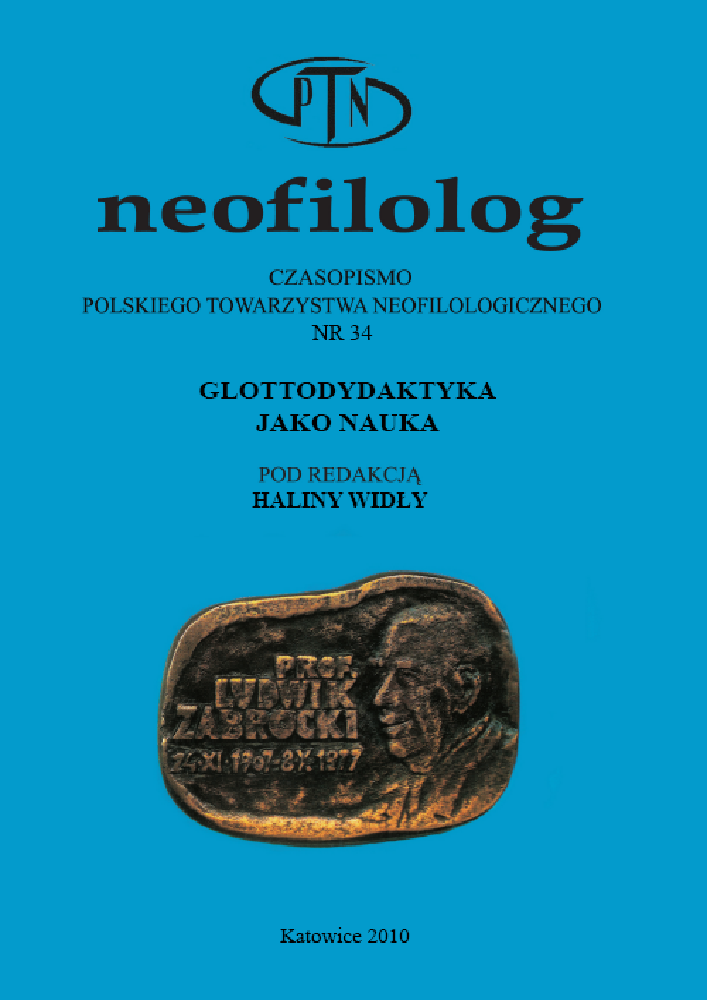Abstrakt
This article discusses the most popular diagnostic instruments employed when exploring the role of individual learner differences in foreign/second language acquisition. It thus focuses on the advantages and disadvantages of the quantitative research tradition, which relying on data recorded in numerical form, resorted to various inventories, but most importantly questionnaires designed for a specific research objective. In spite of their obvious drawbacks, highly structured questionnaires do not in any way seem to be devoid of certain research merits. However, since quantitative and qualitative research approaches represent different ways of thinking about and understanding the surrounding world, it is more advisable to adopt compromise in research, which will enable the researcher to place the phenomenon explored in a wider perspective.
Bibliografia
Carroll, J.B., Sapon, S. 1959. The Modern Languages Aptitude Test. San Antonio, TX: Psychological Corporation.
Cohen, A.D., Dörnyei, Z. 2002. “Focus on the language learner: Motivation, styles, and strategies.” (w) An Introduction to Applied Linguistics: 170 – 190, (red. N. Schmitt). London: Edward Arnold.
Cohen, A.D., Oxford, R.L., Chi, J.C. 2002. Learning Style Survey. The SBI Institute, June, 2001, także: http://carla.acad.umn.edu/profiles/Cohenprofile.html DW 10.05.2008.
Cohen, A.D., Scott, K. 1996. “A synthesis of approaches to assessing language learning strategies.” (w) Language Learning Strategies Around the World: Cross-Cultural Perspectives: 89 – 106. (red. R.L. Oxford). Honolulu: Hawaii University Press.
Dewaele, J.M., 2002. “Psychological and sociodemographic correlates of communicative anxiety in L2 and L3 production.” International Journal of Bilingualism, 6: 23 – 39.
Dörnyei, Z. 2001. Teaching and Researching Motivation. Harlow: Longman.
Dörnyei, Z. 2005. The Psycholog y of the Language Learner. Individual Differences in Second Language Acquisition. Mahwah, New Jersey: Lawrence Erlbaum.
Eliason, P.A. 1995. ”Difficulties in cross-cultural learning styles assessment.” (w) Learning Style in the ESL/EFL Classroom: 19 – 33. (red. J.M. Reid). Boston: Heinle and Heinle.
Ellis, R. 2004. “Individual differences in second language learning”, (w) The Handbook of Applied Linguistics: 525 – 551, (red. A. Davies, C. Elder). Oxford: Blackwell.
Horwitz, E. K. 2000. “It ain’t over till it’s over. On foreign language anxiety, first language deficits, and the confounding of variables.” Modern language Journal, 84/2: 256 – 259.
Horwitz, E.K., Horwitz, M.B. Cope, J., 1986. “Foreign language classroom anxiety.” Modern Language Journal, 70: 125 – 132.
Gardner, R.C., Lambert, W.E. 1972. Attitudes and Motivation in Second Language Learning. Rowley, MA: Newbury House.
Gardner, R.C. 1985. Social Psycholog y and Second Language Learning: the Role of Attitudes and Motivation. London: Edward Arnold.
Kinsella, K. 1995a. “Perceptual learning preferences survey”, (w) Learning Styles in the ESL/EFL Classroom: 221 – 231, (red. J.M. Reid). Boston: Heinle and Heinle.
Kinsella, K. 1995b. „Understanding and empowering diverse learners in the ESL classroom”, (w) Learning Styles in the ESL/EFL Classroom: 170 – 194, (red. J.M. Reid). Boston: Heinle and Heinle.
Lesiak-Bielawska, E.D. 2008a. „Różnice indywidualne i ich role w procesie akwizycji językowej.”Jęz yki Obce w Szkole numer specjalny 6: 15 – 26.
Lesiak-Bielawska, E.D. 2008b. “The relationship between learning style preferences and reading strategy use in English as a foreign language.” Glottodidactica XXXIV: 93-103. Poznań: Adam Mickiewicz University Press.
MacIntyre, P.D., Gardner, R.C. 1994. “The subtle effects of language anxiety on cognitive processing in the second language.” Language Learning, 44: 283 – 305.
Myers, I.B., McCaulley, M.H. 1985. Manual: A Guide to the Development and Use of the Myers-Briggs Type Indicator. Palo Alto, CA: Consulting Psychologist.
O’Malley, J.M., Chamot, A.U. 1990. Learning Strategies in Second Language Acquisition. Cambridge/New York: CUP. Chamot, A.U., O’Malley, J.M. 1994. The CALLA Handbook. Implementing the Cognitive Academic Language Learning Approach. New York: Addison Wesley Longman.
Oxford, R.L. 1990. Language Learning Strategies. What Every Teacher Should Know. New York: Newbury House.
Oxford, R.L., Nyikos, M. 1989. “Variables affecting choice of language learning strategies by university students.” The Modern Language Journal 73/3: 291 – 300.
Piechurska-Kuciel, E. 2008. Language Anxiety in Secondary Grammar School Students. Opole: Wydawnictwo Uniwersytetu Opolskiego.
Prokop, I., Wiśniewska D. 2002. “Metodologia i narzędzia badawcze zastosowane w projekcie.” (w) Autonomizacja w dydaktyce jęz yków obcych. Doskonalenie się w komunikacji ustnej: 109 – 128, (red. W. Wilczyńska). Poznań: Wydawnictwo Naukowe UAM.
Reber, A.S., Reber, E.S. 2001. The Penguin Dictionary of Psycholog y. London: Penguin Books Ltd.
Skehan, P. 1989. Individual Differences in Second Language Learning. London: Edward Arnold.
Skehan, P. 1991. “Individual differences in second language learning.” Studies in Second Language Acquisition, 13/2: 275 – 298.
Skehan, P. 1998. A Cognitive Approach to Language Learning. Oxford: Oxford University Press.
Spielmann, G., Radnofsky, M.L. 2001. “Learning language under tension: New directions from a qualitative study.” Modern language Journal, 85/2: 259 – 278.
Weaver, S.J., Cohen, A.D. 1997. Strategies-Based Instruction: A Teacher Training Manual. CARLA Working Papers Series 7. Minneapolis, MN: Center for Advanced Research on Language Acquisition, University of Minnesota.
Licencja
Prawa autorskie (c) 1970 Elżbieta Danuta Lesiak-Bielawska

Utwór dostępny jest na licencji Creative Commons Uznanie autorstwa – Bez utworów zależnych 4.0 Międzynarodowe.
Przedstawiany utwór (artykuł) upubliczniany jest na podstawie umowy z autorem i na licencji Creative Commons Attribution-NoDerivatives 4.0 International (CC BY-ND 4.0).
Użytkownicy mają obowiązek podania wraz z rozpowszechnionym utworem, informacji o autorstwie, tytule, źródle (odnośniki do oryginalnego utworu, DOI) oraz samej licencji;
- bez tworzenia utworów zależnych,
- utwór musi być zachowany w oryginalnej postaci.
Uniwersytet im. Adama Mickiewicza w Poznaniu zachowuje prawo do czasopisma jako całości (układ, forma graficzna, tytuł, projekt okładki, logo itp.).
